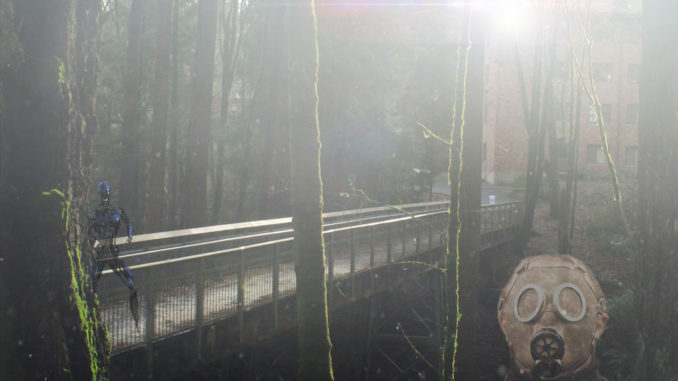
*The Backdoor is a “work” of “fiction” and “humor”
By Nick Sabatini
Mishel Meorge, Associate Vice President of Facilities, revealed that construction of the new bridge over the ravine has been delayed until August 2043. An email sent to the Lewis & Clark student body on Jan. 23 stated some details of the closure. The email said that the existing bridges, made of Lincoln Logs, are about to topple over any day now. Additionally, 981 more permits are needed to start construction. This includes a noise permit, a sweeping up the leaves permit, a walking in the ravine permit and a permit to apply for permits to permit the issuing of permits and that will permit construction unless the city doesn’t permit the permits or permits for permits to issue permits. The permits sound confusing, but it kinda makes sense when you don’t permit yourself to think about it.
The main reason for the delay is the administration’s decision to hire sloths to do construction work. In the midst of a budget crisis, LC cannot afford to pay human workers. Although sloths are known for being sluggish, they demand a pay far less than that of humans. They can work long hours without complaining, and they are kinda cute to play with.
“The new bridge will be well worth the wait,” Meorge said.“Unlike the previous bridges, the new bridge will feature six lanes of traffic: a carpool lane, a fast lane, a slow lane, a lane with a moving walkway and a lane exclusively for campus safety in the event of a high speed chase across the bridge. Lego bricks have been selected as the bridge’s material. Legos are considered sturdier than Lincoln Logs, the material of the previous bridges. I used to play with Legos when I was a kid. My Lego houses were always sturdy and never fell apart. That is how I knew Lego would be a perfect material for the new bridge.”
Hopefully, the new bridge will last longer than the old ones.
“The previous bridges lasted five days,” Meorge said, not even glancing up from his Lego instruction manual titled “How to Build a Bridge.” In front of him was a crayon sketch of the new bridge. “We hope this new bridge will last a good week or so. We still need to obtain permits and permits for permits from the city. That may be a while, because the city’s planning department also hired sloths.”
Meorge also expressed concern about how to dispose of the old bridges without affecting the protected ravine below. While this is still being determined, classified sources claim that dynamite will most likely be used. Dynamite seems to be the most effective way to get rid of something nobody wants to see anymore. Additionally, very little damage would be done to the ravine, which is strictly protected by the City of Portland. It is also fun to watch things blow up.
“I just crossed the bridge and it seems safe to me,” a student who wished to remain anonymous said. “Whenever I built something with Lincoln Logs, it held up.” Just as he said that, the bridge behind him made a creaking sound after a leaf from the tree above fell onto the walkway. Then, the bridge disappeared from view as it collapsed, meeting its grave at the bottom of the ravine.
Subscribe to the Mossy Log Newsletter
Stay up to date with the goings-on at Lewis & Clark! Get the top stories or your favorite section delivered to your inbox whenever we release a new issue.

Leave a Reply